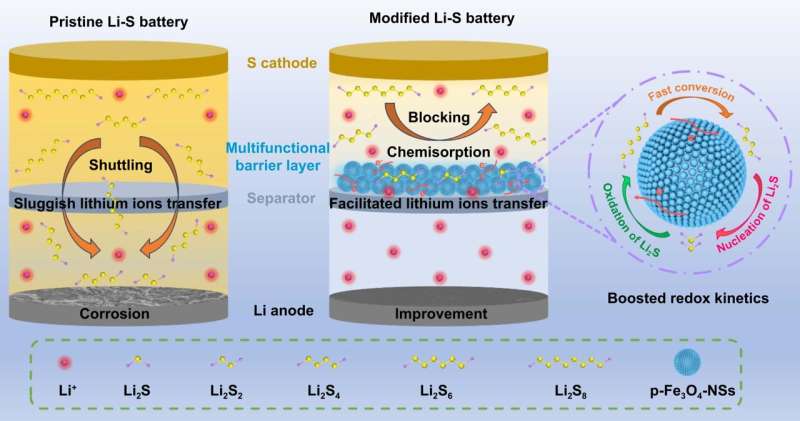Long-life Li-S batteries based on multifunctional separators functionalized by porous mediators

Researchers from the South China University of Technology report on a potential strategy for long-life Li-S batteries via the rational design and low-cost fabrication of multifunctional separators. Due to effective trapping and fast conversion of soluble LiPSs and the strengthened lithium-ion diffusion kinetics during cycling, an ultra-long cycle life of more than 2,000 cycles is achieved for the resultant battery.
The practical applications of Li-S batteries are significantly impeded by the sluggish reaction kinetics of sulfur species and notorious shuttling of soluble LiPSs intermediates that result in low sulfur utilization, rapid capacity fading and shortened cycle life.
Introducing functional separators into the Li-S battery has been proven a quite effective strategy for entrapping LiPSs within the cathodic region or retarding their diffusion across the separator, thus achieving effective suppression of LiPSs shuttling.
In this regard, many studies have reported separators functionalized by the nanostructured carbon, polar hetero-atom doped carbon and metal-based compounds for blocking LiPSs shuttling via physical restraint or chemisorption effects. Although these functional layers on separators can effectively restrict the migration of LiPSs, the electrochemical performances of Li-S batteries are still far from satisfactory.
On one hand, the soluble LiPSs are solely blocked by these functional separators, which cannot be further converted into insoluble species (Li2S2/Li2S for discharging and sulfur for charging) for reutilization, leading to a lower utilization rate of active materials. On the other hand, the functional layers on separators without rational structure design may inevitably block the transport of lithium ions, weaken the electrochemical reaction kinetics, and finally compromise the rate performance of batteries.
Furthermore, the relatively complicated and costly preparation of functional layer materials using tedious multi-step procedures, expensive raw materials/precursors, or some harsh conditions inevitably bring about some drawbacks like high production cost, low output efficiency, and scalable fabrication problems. Therefore, it remains challenging to develop cost-effective and high-performance separators with powerful regulation capability for LiPSs control and conversion, while maintaining rapid lithium-ion transfer to strengthen the sulfur redox kinetics.
Published in the journal International Journal of Extreme Manufacturing, the article by the research team from the South China University of Technology proposes a novel multifunctional separator to simultaneously address these issues. The hollow and hierarchically porous Fe3O4 nanospheres (p-Fe3O4-NSs) are prepared via the self-assembly of numerous extremely-small Fe3O4 nanocrystals, and proposed as a proof-of-concept functional layer to construct a multifunctional separator for strengthening the electrochemical reaction kinetics in Li-S batteries.
The resultant batteries have worked efficiently with excellent electrochemical performances due to efficient regulation of LiPSs during cycling. This work demonstrates a feasible strategy to construct long-life Li-S batteries through the rational design and low-cost fabrication of multifunctional separators to achieve high sulfur utilization.
The lead researcher, Professor Wei Yuan, commented, "[The] modifying separator is a promising strategy to regulate the LiPSs behavior in the battery. An ideal separator for Li-S battery should be multifunctional and meet several critical demands like strong blocking capability toward LiPSs to restrain their migration, excellent affinity with the electrolyte to enhance the transport kinetics of lithium ions across the separator, considerable conversion activity to facilitate the fast transformation of the trapped LiPSs to insoluble species. We [made] such awesome progress to achieve high sulfur utilization and highly long cycle life for Li-S batteries via the rational design and low-cost fabrication of multifunctional separators."
It is of great importance to control and reutilize the soluble LiPSs for developing a long-life Li-S battery. The first author Xiaoqing Zhang explained, "In our work, we show that the soluble LiPSs can be efficiently immobilized and converted to the insoluble species by the newly-designed separator. The hollow and hierarchically porous mediator is proposed as a functional layer on [the] separator, which can provide chemical adsorption toward LiPSs and kinetically promote the mutual transformation between LiPSs and Li2S2/Li2S during cycling, thus inhibiting the LiPSs shuttling and boosting the redox reaction kinetics via a chemisorption-catalytic conversion mechanism." This multifunctional separator endows the device with an admirable rate performance, ultra-long cycling performance and a high areal capacity under high-sulfur-loading and lean-electrolyte conditions.
"Our team has developed many novel electrode structures to tackle the dissolution and shuttling problems of LiPSs in [an] Li-S battery." Professor Wei Yuan said, "In addition to addressing these issues, how to effectively strengthen the electrochemical reaction kinetics is another key factor to obtaining practical battery devices. We are devoted to exploring some promising strategies to advance the practical applications of battery devices."
More information: Xiaoqing Zhang et al, Rational design and low-cost fabrication of multifunctional separators enabling high sulfur utilization in long-life lithium-sulfur batteries, International Journal of Extreme Manufacturing (2022). DOI: 10.1088/2631-7990/aca40b

















